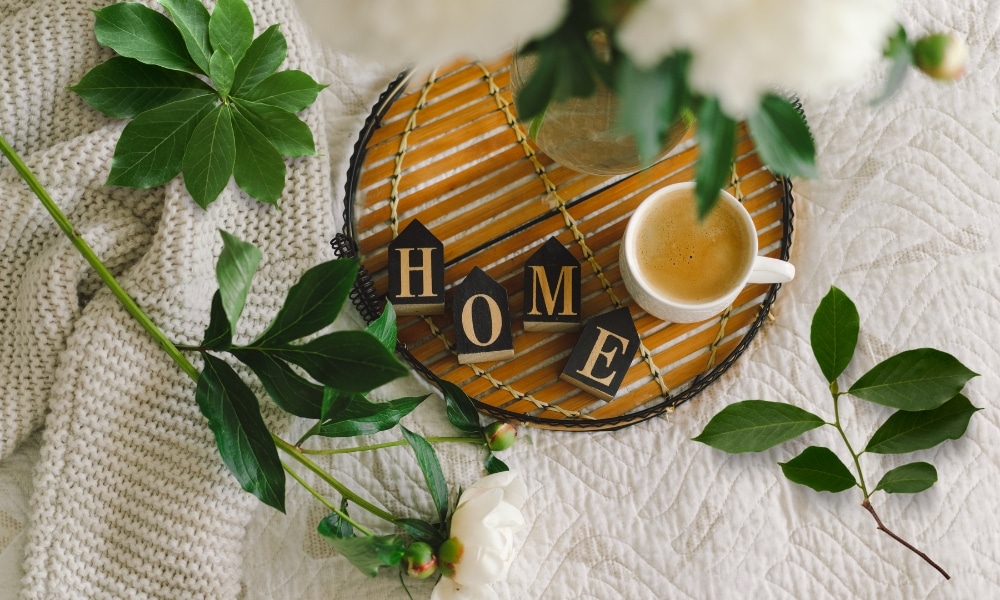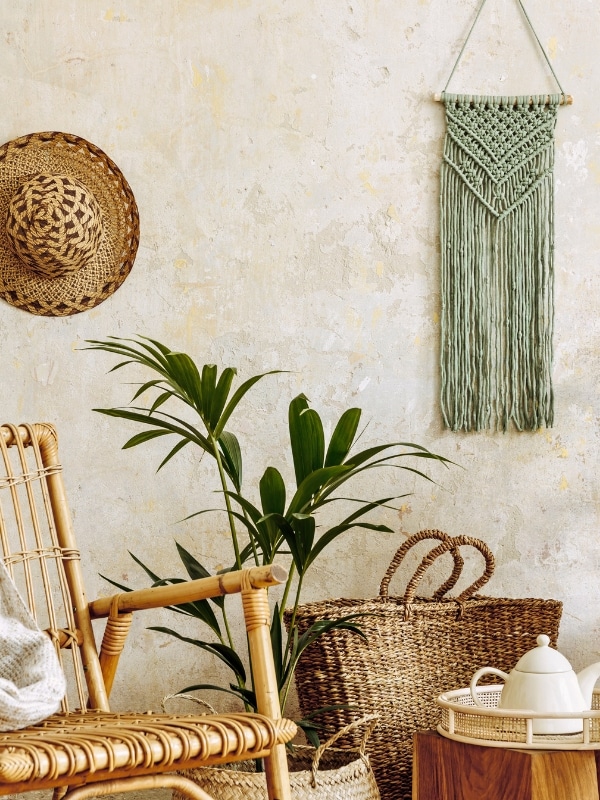Creating a beautiful and comfortable home doesn’t have to come at the expense of the environment. In Australia, a growing awareness of environmental issues is driving a surge in interest in sustainable home décor.
This approach focuses on making conscious choices about the materials, products, and practices used to style our homes. It aims to minimise our impact on the planet while creating stylish and healthy living spaces. This comprehensive guide delves into the world of sustainable home décor in Australia, exploring practical tips, innovative ideas, and the benefits of embracing an eco-friendly lifestyle.

On this page
Why sustainable home décor matters
The choices we make in our homes have a significant impact on the environment. Traditional home décor often involves materials and processes contributing to deforestation, pollution, and waste. By embracing sustainable home décor, we can reduce our carbon footprint, conserve resources, and create healthier living environments. According to the 2023 Australian Institute of Architects report, buildings are responsible for approximately 20% of Australia’s greenhouse gas emissions. Sustainable design and décor play a crucial role in mitigating this impact.
Check our page to learn how to calculate your carbon footprint.
Did you know Energy Matters is Australia’s largest renewable news, blog and educational resource? Subscribe to Energy Matters’ weekly newsletter and keep updated even with incentives, rebates and recommended solar product offers.
Key principles of sustainable home décor
To effectively incorporate sustainable home décor ideas, it’s essential to understand the core principles that define eco-friendly home styling:
- Eco-friendly materials: Use of sustainable materials. Choosing renewable, recycled, or sustainably sourced materials is fundamental. This includes timber from certified forests, bamboo, cork, recycled materials, sustainability to interior spaces, low-volatile organic compound (VOC) paints and finishes.
- Energy efficiency: Integrate design elements and appliances that minimise energy consumption. This includes using energy-efficient lighting appliances and maximising natural light to reduce reliance on artificial sources.
- Waste reduction: Embrace practices that minimise waste, such as upcycling existing furniture, choosing durable products, and selecting items with minimal packaging.
- Durability and longevity: Investing in high-quality, durable pieces that will last for years reduces the need for frequent replacements and minimises waste.
- Locally sourced products: Supporting local artisans and businesses reduces transportation emissions and promotes local economies.
- Indoor air quality: Select non-toxic materials and finishes to enhance indoor air quality. Low-VOC paints, natural fibre textiles, and houseplants can improve air purity and create a healthier living environment.
- Health and wellbeing: Choosing non-toxic materials and creating spaces with good ventilation and natural light contributes to a healthier indoor environment.
Sustainable home décor ideas for Australian homes

1. Eco-friendly furniture selection
Investing in furniture made from sustainable materials is a cornerstone of green interior design. Look for pieces crafted from certified sustainable wood or reclaimed materials. Brands prioritising ethical manufacturing processes and durability ensure that furniture lasts longer and has a reduced environmental impact.
2. Incorporation of natural elements
Bringing natural elements into interior spaces fosters a connection with the environment. Houseplants not only enhance aesthetics but also improve air quality. Materials like stone, cork, and jute can add texture and warmth to flooring, wall coverings, and accessories
3. Sustainable textiles
Choose textiles from organic or recycled fibres for curtains, upholstery, and rugs. Organic cotton, linen, and hemp are excellent options that offer durability and a reduced environmental footprint.
4. Water conservation features
Incorporate fixtures and fittings that promote water efficiency. Low-flow faucets, dual-flush toilets, and water-efficient showerheads can significantly reduce water consumption without compromising performance.
5. Use of non-toxic paints and finishes
Traditional paints can release volatile organic compounds (VOCs) into the air, affecting indoor air quality. Opt for low or zero-VOC paints and finishes to create a healthier living environment.
6. Upcycling and repurposing
Before discarding old furniture or décor items, consider how they might be repurposed or upcycled. A fresh coat of eco-friendly paint or minor modifications can give new life to outdated pieces, reducing waste and adding unique character to your home.
7. Energy-efficient lighting
Lighting plays a crucial role in a home’s functionality and ambience. Use LED lighting solutions, which consume less energy and have a longer lifespan than traditional bulbs. Additionally, consider installing dimmer switches and motion sensors to conserve energy further.
Sustainable Home Décor Ideas for every room

Living room
- Furniture: Opt for furniture made from sustainable timber, bamboo, or recycled materials. Consider reupholstering existing pieces with natural fabrics like organic cotton or linen.
- Flooring: Choose sustainable options like bamboo, cork, or reclaimed timber.
- Textiles: Use organic cotton, linen, or wool for curtains, cushions, and throws.
- Lighting: Switch to energy-efficient LED lighting and maximise natural light.
Bedroom
- Bedding: Choose organic cotton or bamboo sheets and bedding.
- Furniture: Select furniture made from sustainable materials and consider secondhand or vintage pieces.
- Décor: Use natural materials like wool, cotton, and linen for rugs and wall hangings.
Kitchen
- Cabinets: Opt for cabinets made from sustainable timber or recycled materials.
- Countertops: Choose sustainable countertop materials like recycled glass or bamboo.
- Appliances: Select energy-efficient appliances with high star ratings.
Bathroom
- Fixtures: Install water-saving fixtures like low-flow showerheads and dual-flush toilets.
- Tiles: Choose tiles made from recycled materials or natural stone.
- Textiles: Use organic cotton towels and bath mats.
The benefits of sustainable home décor
Embracing sustainable home décor offers numerous benefits:
- Environmental protection: Reduces your carbon footprint and conserves resources.
- Healthier living environment: Minimises exposure to harmful chemicals and toxins.
- Cost savings: Energy-efficient practices and durable products can save money in the long run.
- Unique and stylish home: Sustainable décor often has a unique and personal touch.
- Support for local communities: Choosing locally sourced products supports local businesses and artisans.
Challenges and considerations
While adopting sustainable home décor is on the rise, challenges remain. One significant barrier is the perception of higher costs associated with eco-friendly products. However, it’s essential to consider the long-term savings achieved through energy efficiency and the durability of sustainable materials.
Additionally, the availability of sustainable products can vary, and consumers may need to invest time in sourcing items that meet their environmental criteria. Engaging with local artisans, exploring second-hand markets, and supporting companies with transparent sustainability practices can mitigate these challenges.
- Cost: Sustainable materials and products may sometimes be more expensive upfront.
- Availability: Finding sustainable options may require more research and effort.
- Greenwashing: Be wary of companies that make misleading claims about their products’ sustainability.
Sources: Sustainable Chic: Eco-Friendly Interior Design Trends Shaping Australia’s Homes in 2024 – Medium l Australia Home Decor Market Insights Discussed Regarding Industry Trends, Share, Size, Growth, Opportunity and Forecast 2024-2032 – WhaTech l Sustainable Home Décor – Cozy Earth l Eco-Friendly Bedroom Design Doesn’t Have to Be a Snooze – Mansion Global
The future of sustainable home décor
The future of sustainable home décor in Australia looks promising. As awareness of environmental issues continues to grow, more and more people are embracing eco-friendly practices in their homes. The increasing availability of sustainable products and the growing support for local artisans and businesses are also positive trends.
Sustainable home décor is not just a trend; it’s a responsible and stylish way to create a beautiful and environmentally conscious home. By making informed choices about the materials, products, and practices we use in our homes, we can minimise our impact on the planet and create healthier living spaces for ourselves and future generations. It’s about more than just aesthetics; it’s about creating a home that reflects our values and contributes to a sustainable future.
Energy Matters encourages you to take the first step towards a sustainable home today. Explore the many eco-friendly home styling and green interior design ideas and create a beautiful and environmentally responsible space.
Take the next step towards a sustainable future from Energy Matters
The future of solar power is beyond our skies—are we ready to harness its full potential?
Energy Matters is here to guide you every step of the way. Energy Matters is one of Australia’s most trusted solar quotes due to our high customer satisfaction and industry recommendations. Our team of solar experts can help you get up to 3 FREE solar quotes from pre-qualified and vetted solar firms in your area.















































